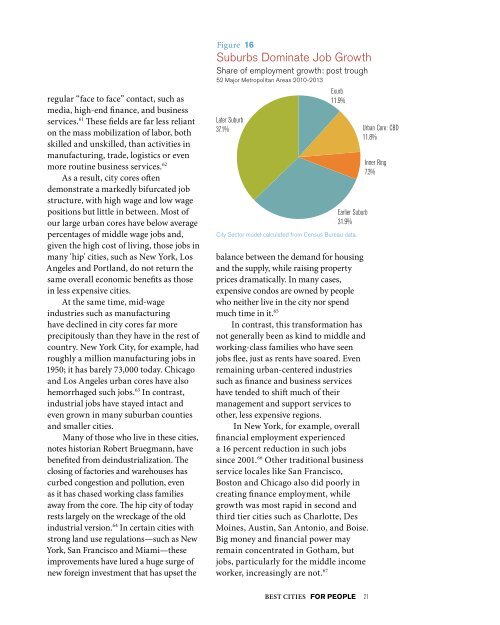FOR PEOPLE
1ONa2xt
1ONa2xt
You also want an ePaper? Increase the reach of your titles
YUMPU automatically turns print PDFs into web optimized ePapers that Google loves.
Source: The Brooklings Institution, U.S. Census Bureau<br />
regular “face to face” contact, such as<br />
media, high-end finance, and business<br />
services. 61 These fields are far less reliant<br />
on the mass mobilization of labor, both<br />
skilled and unskilled, than activities in<br />
manufacturing, trade, logistics or even<br />
more routine business services. 62<br />
As a result, city cores often<br />
demonstrate a markedly bifurcated job<br />
structure, with high wage and low wage<br />
positions but little in between. Most of<br />
our large urban cores have below average<br />
percentages of middle wage jobs and,<br />
given the high cost of living, those jobs in<br />
many 'hip' cities, such as New York, Los<br />
Angeles and Portland, do not return the<br />
same overall economic benefits as those<br />
in less expensive cities.<br />
At the same time, mid-wage<br />
industries such as manufacturing<br />
have declined in city cores far more<br />
precipitously than they have in the rest of<br />
country. New York City, for example, had<br />
roughly a million manufacturing jobs in<br />
1950; it has barely 73,000 today. Chicago<br />
and Los Angeles urban cores have also<br />
hemorrhaged such jobs. 63 In contrast,<br />
industrial jobs have stayed intact and<br />
even grown in many suburban counties<br />
and smaller cities.<br />
Many of those who live in these cities,<br />
notes historian Robert Bruegmann, have<br />
benefited from deindustrialization. The<br />
closing of factories and warehouses has<br />
curbed congestion and pollution, even<br />
as it has chased working class families<br />
away from the core. The hip city of today<br />
rests largely on the wreckage of the old<br />
industrial version. 64 In certain cities with<br />
strong land use regulations—such as New<br />
York, San Francisco and Miami—these<br />
improvements have lured a huge surge of<br />
new foreign investment that has upset the<br />
Figure 16<br />
Suburbs Dominate Job Growth<br />
Share of employment growth: post trough<br />
52 Major Metropolitan Areas 2010-2013<br />
Later Suburb<br />
37.1%<br />
Exurb<br />
11.9%<br />
Earlier Suburb<br />
31.9%<br />
City Sector model calculated from Census Bureau data.<br />
balance between the demand for housing<br />
and the supply, while raising property<br />
prices dramatically. In many cases,<br />
expensive condos are owned by people<br />
who neither live in the city nor spend<br />
much time in it. 65<br />
In contrast, this transformation has<br />
not generally been as kind to middle and<br />
working-class families who have seen<br />
jobs flee, just as rents have soared. Even<br />
remaining urban-centered industries<br />
such as finance and business services<br />
have tended to shift much of their<br />
management and support services to<br />
other, less expensive regions.<br />
In New York, for example, overall<br />
financial employment experienced<br />
a 16 percent reduction in such jobs<br />
since 2001. 66 Other traditional business<br />
service locales like San Francisco,<br />
Boston and Chicago also did poorly in<br />
creating finance employment, while<br />
growth was most rapid in second and<br />
third tier cities such as Charlotte, Des<br />
Moines, Austin, San Antonio, and Boise.<br />
Big money and financial power may<br />
remain concentrated in Gotham, but<br />
jobs, particularly for the middle income<br />
worker, increasingly are not. 67<br />
Urban Core: CBD<br />
11.8%<br />
Inner Ring<br />
7.3%<br />
BEST CITIES <strong>FOR</strong> <strong>PEOPLE</strong> 21




